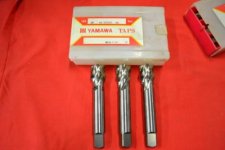AMMASHOOTA
Gary Gruber
it's been 30+ years since i have broken a tap in a hole. tonight i broke a $120 carbide tap the first time i used it. fortunately, i was able to extract the broken piece and save the item i was tapping.
As you might know, I am in the Machine Shop Business. We do, on rare occasions, break taps. We usually have them disentegrated, there is a company in Houston that has portable Carbon Arc burners that do it for about $150.
The main culprits in tap breakage are the tap going crooked into the hole. Second is too small of a tap drill, and of course, bottoming one out and a dull tap.
I have to ask. $150 seems quite expensive for any tap that would be used in Gun work. What size was it? We just bought a new 1 1/2 6tpi plug tap for about $125.
As you might know, I am in the Machine Shop Business. We do, on rare occasions, break taps. We usually have them disentegrated, there is a company in Houston that has portable Carbon Arc burners that do it for about $150.
The main culprits in tap breakage are the tap going crooked into the hole. Second is too small of a tap drill, and of course, bottoming one out and a dull tap.
I have to ask. $150 seems quite expensive for any tap that would be used in Gun work. What size was it? We just bought a new 1 1/2 6tpi plug tap for about $125.
Carbide taps are really for production work in a machining center. They are certainly not intended to be hand taps. They'll snap off easy as pie if you apply side pressure on them. If you really have to use a carbide tap manually, at least set it up in the mill and use a dead center to hold the tap wrench.
Any of the really nice quality taps will tap your action materials without any problems. Emuge taps for high alloyed materials are very nice and not near so pricey. You can get a 10-32 for $35 or so on sale. I'd say you can tap materials in the high 40s with them. 4100 series steels max out around 46, so even if its at max hardness, they'll do the job. Not saying it'll do it for long, but, a hole or 3 should be no issues with good tap fluid. Personally, I like coolant at full strength for most steels.
Emuge taps for high alloyed materials are very nice and not near so pricey. Y.
"Ruger bolts (rimfire) are hardened. i purchased carbide spot drill and tap drill to attach a 'racker' to the bolt. the after market rackers use clamping action that weakens the aluminum surrounding a might large dovetail. Invariably, the clamp portion of the racker fails at the joint from excessive pressure to keep it together. they are $80 each and rarely last more than 3-4 months in heavy competition."
I'm curious, what do you mean by a "Racker", and what model of Ruger rimfire are you attaching it to?
Is this on a pistol, or rifle?
You might look into the possibility of spot annealing the area you'll be drilling and tapping.
Jerry,There are some rally cool videos at the Emuge web site. I especially love the Z-axis/C-axis portion.
http://www.emuge.com/videos/32rc.html
ammashoota,
MkI & early MkII bolt tabs were serrated square,not tapered.
The bolt tab is welded to aft end of the bolt.
A 5/16" stud locates the tab & is fusion TIG welded,blended.
Don't add too much weight,or the tab will break off-I've TIG welded <100.
Dumb question: Why don't they have a tap that cuts half the thread depth and another to cut the remaining depth or do they?
Ron

